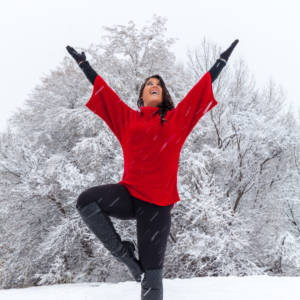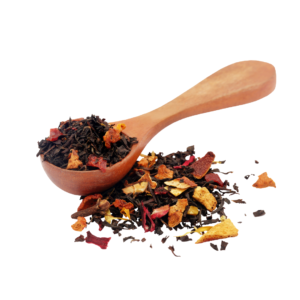Shishir Ritu- Late Winter
Shishir Ritu in Ayurveda is related to the late winter season. In India those dates range from Mid-January to Mid-March. Those dates might be different based on the climate where you live. For myself, living in Minnesota those are accurate dates for our climate. If you live in a more tropical climate such as Hawaii you might adjust those dates to fit your climate needs.
The dosha most predominant during this season is the kapha dosha. When we look at what gunas or qualities are occurring at this time we often observe; dry, heavy, cold, and sticky qualities happening outside. The qualities happening outside in mother nature also affect what’s happening inside our bodies.
The yoga asana poses were chosen to help you reduce the accumulating kapha in the body at this season. The emphasis will be on back bends, laterals and inversions. The seasonal routine is meant to move stuck energy in the mind and body, and the rituals and remedies to bring circulation and movement into the lymph system. The purpose of the movement is to help reduce the buildup of kapha in the body which when out of balance might look like no motivation, lack of energy, and an overall heavy feeling in the mind and body.

Understanding Shishir Ritu
Shishir Ritu is known as the late winter season, usually the months of mid-January-mid March. The winter season in Ayurveda is all about silence, stillness and sleep. It’s a time to go inwards to recharge and reflect. The winter is the dreaming phase. It’s the time to think about what goals you want to achieve in the coming months but not to act on them.
A few Shishir Ritu practices are journaling, meditation and abhyanga are wonderful practices to incorporate during these often colder winter months.
Journaling prompts for the winter season to get you started dreaming into new possibilities;
- How do you feel about the darker winter months?
- What habits do you want to work on this winter season?
- What seeds do you want to plant for the Vasant Ritu (spring) season?
- What is winter trying to teach me this year?
Another practice to focus on during the winter season is your digestion, keeping your agni high. Agni is your digestive fire. If your digestive fire starts to burn low, your digestion starts to slow down. That is why in the winter season eating warm, cooked, oily foods are recommend in Ayurveda.
If you think about your digestion as a fire if you overfeed a fire it will snuff itself out. Likewise if you don’t feed the fire enough it will stop burning. You want to stoke the agni (your digestion) throughout the day with cooked foods and sipping on warm or room temperature water. See the recipe section for ideas on what recipes to cook this season.

Sacred Seasons
Explore and embody Ayurvedic wisdom to live a cyclical life you love.
For yoga teachers, students or anyone wanting to deepen their inner wisdom.
Sacred Seasons is for the insight-seekers, life-long learners, and for those ready to choose a new path inspired by ancient ways.
In our fast-paced world the rhythms of the sun, the moon and the seasons can often go unnoticed, but they affect us all.

Your Shishir Ritu Plan Overview
In the later winter months there is an emphasis on warming and movement practices to help reduce the building kapha dosha in the atmosphere and in the body. A few practices that are recommend in Ayurveda are Jentaka, which is a practice similar to a modern day sauna practice. According to the Cleveland Clinic benefits of the infrared saunas are improved heart health, sooth sore muscles, pain relief, relaxation, better sleep and fighting off illness. A sauna practice can be done 3-4 times a week. You can slowly build up your time from 10 minutes a session up to 30 minutes a session once you feel comfortable in the heat.
Your daily routine in the Shishir Ritu season will be one that focuses on building in time for inner reflection, bringing heat into the body, time to get outside in nature and making sure you exercise in the morning hours.
The foods you will want to enjoy should focus on being nourishing to your body. Warm, cooked and heavier foods at this season will feel good in your body. There are sample recipes in this book for you to try if you are looking for a good place to start. Finally a daily practice to incorporate is movement read more about what movement is best for you.

Sample Daily Routine
In Ayurveda ideally you wake up around 6am, have a bowel movement, scrape your tongue, perform yoga asana (see a sample routine on page ), practice pranayama and finish with a meditation practice. This morning routine can be as short as 15 minutes, or up to an hour depending on how much time you have and want to devote to a morning routine. An afternoon practice might look like a second meditation practice or a yoga nidra mid-day to transition into the evening portion of your day. You might finish your day with an early, lighter, dinner a mindful evening practice of your choice and an abhyanga practice (page ) before you go to bed to help you sleep at night.

Sample Daily Menu
In Shishir Ritu we want to emphasis warm, cooked foods. A great way to start your day is with oatmeal. If you’re a coffee drinker try adding a pinch of cardamom to your coffee to take out some of the acidity that can build up from regularly drinking coffee. Ideally you don’t snack in between meals in Ayurveda especially in the winter months to keep kapha from getting stagnant. Lunch is ideally your biggest meal around the 12pm hour. If you are a meat eater, enjoying meat at this time of day when it’s easier to digest vs your evening meal is recommend. Finally in the winter months finishing dinner by 6pm and enjoy soups, or lightly cooked vegetables is ideal to keep your agni high.

Sample Daily Movement Practice
The best way to reduce kapha in the body is by moving the body. In the winter months more vigorous movement can be performed without as many side affects as during the warmer months. A daily movement practice for the vata dosha could look like incorporating yoga asana into your morning routine, and going for a walk after lunch. If you’re a pitta dosha you might prefer to lift heavy weights, or go to a more intense workout class. If you’re a kapha dosha doing movement first thing in the morning so you won’t skip it is best. Whether that be lifting weights, yoga asana, going for a walk or take a barre class. What routine are you most likely to stick with is the key!

Modification Tips
Daily routines can be very challenging for the imbalanced vata dosha. If you’re struggling with sticking to your routine make minor adjustments. If you hate going for a walk when it’s dark and cold outside, shift your nature time to be after lunch when the sun is the warmest, and make sure you invest in warm winter clothes if you live in a colder climate.
If you feel as if your routine is making you feel very rigid and like you’re going through the motions you might be feeling a bit of a pitta imbalance. Make space for a free choice at some point of your day to feel nourished.
If waking up early is causing you issues make sure you’re going to bed around 10pm. In the cold, dark winter months waking up early can be challenging. Make sure you set yourself up for success by going to bed on time, setting out your clothes the night before, making sure where you do your morning routine is all ready for you in those early morning hours. The more you can plan ahead the better your future self will feel.
Finally if you have food allergies or can’t stand an ingredient on one of the recipes, you can either eliminate it or substitute it. If you chose to substitute it, pick an ingredient that will have the same effect on the body. Cinnamon is a warming spice if that’s not something you enjoy substitute it with cardamom. Ayurveda is all about adapting the practices to work for you. If you can’t digest rice, but quinoa works for you make that substitution.

Preparing for Shishir Ritu
The late winter season is all about continuing to provide warmth in the body both internally and externally, movement in the body and mind and practices that will keep you grounded and centered.
The next section will provide you with a yoga asana sequence you can do to start your day. For the yoga sequences you don’t need any props. If you have a yoga mat feel free to use that, and if your practice includes yoga blocks you might want those handy. To truly practice yoga you really just need yourself and your breath.
Our next section will focus on rituals to incorporate during the Shishir Ritu season. For those practices you will need a bathtub (though a shower can work), epsom salt. Optional, you can have herbs of your choice such as lavender, roses, eucalyptus, hops or ginger. For the 5 senses practice you will need a rock/crystal, essential oils and cinnamon or cardamom in a cup of warm drinking water.
Finally we will finish with a few seasonal remedies that are geared to pacify the kapha dosha. For those remedies you might want to have on hand sesame oil, or lavender oil.
The Shishir Ritu season is a time to be mindful of the accumulation of kapha in the body. When we think about the snow at this time of the year it is heavy, wet and the air is very dry outside. Make sure you bring in the opposite qualities to stay balanced during this season.

Healthy Living Tips for Shishir Ritu
When starting new habits you want to remember that small bite size changes are key. You don’t have to overhaul your entire life to incorporate these remedies and rituals into your routine. If you are using this book as your guide throughout each season, you can switch out a current seasonal habit for one that is new to the upcoming season.
Most of the practices in the late winter section are morning practices (except the cleansing energy ritual bath). You can pair habits together to make sure you will do them and start your day off right. After you scrape your tongue and brush your teeth you can do your Kapalabhati practice, next you can do your yoga asana practice, followed by 5 senses exploration.
To finish your day you might do the abhyanga practice right before you take your cleansing ritual bath. These don’t have to be practiced daily, but try to commit to a schedule that is consistent and works for you.
I’ve found when you start to skip your new habits it can lead to a snowball effect and you might have a more difficult time adding those habits back into your routine. Think about how easy you can make these practices fit into your day. Again, 5 minutes will go a long ways to helping you build sustainable long term habits. In Ayurveda the more we practice the same habits day in and day out the more grounding and nurturing it is for the vata dosha long term.
End Of Season Takeaways
The Shishir Ritu season is typically from Mid-January-Mid-March. The late winter season is associated with the kapha dosha and the gunas at this season are; dry, heavy, cold, and sticky. Reminder that the qualities happening outside in mother nature are also what’s affecting you inside your body. Noticing what your late winter season looks and feels like where you live. Everyone will have a different experience based on your climate needs, as well as your doshic needs during that season of your life.
Key Takeaways
- Shishir Ritu is associated with late winter and the kapha dosha
- The gunas at this time are; dry, heavy, cold, sticky, slow, oily, liquid, soft, static, and gross
- Rituals & Remedies at this are focused on reducing accumulation of kapha
- Yoga asana practices are focused on backbends, laterals and inversions
To slowly prepare yourself to transition into Vasanat Ritu you can start to adjust your habits a few weeks before your climate officially enters the spring season. Spring is also associated with the kapha dosha so continuing to pacify the kapha dosha and focusing on reducing accumulation the last month of Shishir Ritu will help you stay balanced all spring season.
Wanting more seasonal wisdom?
Learn about the Sacred Seasons which is the Ayurvedic approach to the season. Learn when it opens next here!

view + leave comments . . .